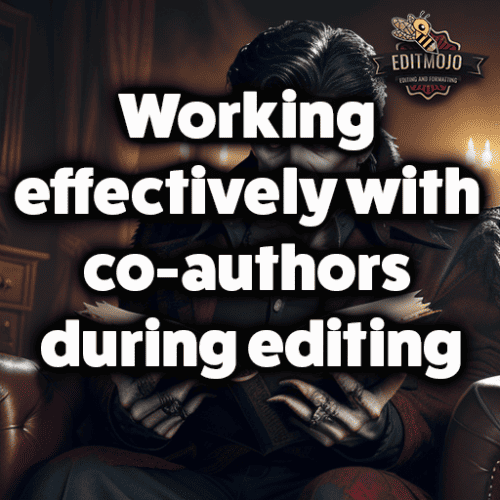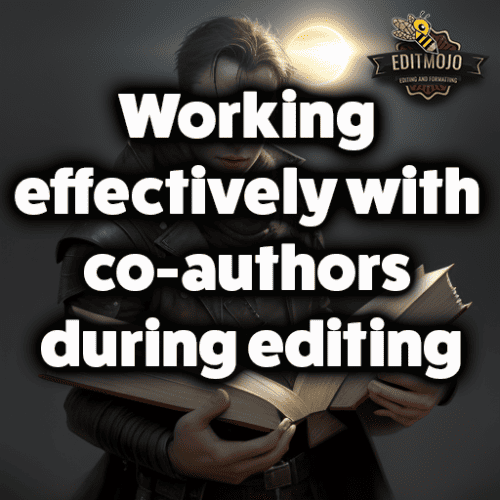Working effectively with co-authors during editing
Working effectively with co-authors during editing. Navigating the writing process is often compared to a voyage. When the voyage involves co-authors, the journey becomes a shared experience, replete with unique dynamics, challenges, and rewards. One key aspect of this collaborative journey is working together effectively during the editing phase. The final product is not just a reflection of each writer’s unique perspective but an amalgamation of thoughts, forming a cohesive narrative that resonates with the readers. In our digital age, platforms like EditMojo.com have emerged as valuable resources that can aid this process by offering professional editing and writing collaboration tools.
Key Takeaways
| Topic | Key Takeaways |
|---|---|
| Understanding the Role of a Co-author | Co-authorship is about partnership and cooperation, with shared responsibilities during the editing process. |
| Navigating Co-author Dynamics | Co-authorship requires effective communication, understanding, and compromise. Diverse perspectives can enhance the depth and richness of the work. |
| Creating a Collaborative Workflow | Successful co-authorship requires clear objectives, an agreed-upon timeline, and assigned roles and responsibilities. Tools like EditMojo.com can aid the process. |
| Effective Communication in Co-authorship | Open and respectful dialogue is crucial. Regular meetings and updates keep everyone on the same page. |
| Managing and Integrating Diverse Writing Styles | Diverse writing styles need to be balanced to maintain stylistic consistency. EditMojo.com can assist in this process. |
| Addressing and Resolving Conflicts | Conflicts should be handled with a focus on compromise and consensus, always with the goal of benefiting the work. |
| Review and Revision: The Final Steps | The review and revision process refines the work. Third-party services like EditMojo.com can offer unbiased and professional reviews. |
| Case Studies: Successful Co-author Collaboration Stories | Stories like Good Omens highlight the importance of synergy and collaboration in co-authorship. |
Understanding the Role of a Co-author
The very essence of co-authorship lies in partnership and cooperation. As a co-author, you don’t just share the task of writing, but also the responsibilities that come with refining, polishing, and perfecting the piece during editing. Think of co-authorship as a musical duet. Each artist contributes to the piece, but the true magic is realized when the individual elements come together to create harmony.
Navigating Co-author Dynamics
Like any partnership, co-authorship can be tricky terrain. It requires a balance of communication, understanding, and a willingness to compromise. Imagine a team of sculptors working on a single piece; one prefers abstract forms while the other swears by realism. There’s bound to be friction. But it’s this very diversity of ideas and perspectives that can add depth and richness to the final masterpiece. The key is in finding common ground and working towards a shared vision.

Creating a Collaborative Workflow
Effective collaboration calls for an organized and structured workflow. Co-authors must agree upon clear objectives, create a timeline, and designate roles and responsibilities. For instance, if you’re working on a science fiction novel with your co-author, you might divide the chapters based on your expertise or interest. You could handle the world-building and character development, while your partner could focus on the plot and narrative structure. It’s crucial to respect each other’s assigned roles, thus maintaining a healthy, productive working relationship.
With the myriad tools available online, enhancing your collaborative workflow has never been easier. Websites like EditMojo.com offer an array of features designed to facilitate smooth collaboration between writers during the editing process.
Effective Communication in Co-authorship
Effective communication is the lifeblood of co-authorship. Regular meetings, updates, and respectful dialogue ensure everyone is on the same page. If you disagree with an edit, articulate your concern constructively. Remember, the goal is not to win an argument, but to produce the best work possible.
Managing and Integrating Diverse Writing Styles
Each author brings a unique writing style to the table, which can be both a blessing and a challenge. Balancing different styles requires a delicate touch. It’s like a potluck dinner, where each dish is delicious on its own, but they need to complement each other to create a satisfying meal.
Professional editing tools like those provided by EditMojo.com can help co-authors maintain stylistic consistency while preserving each writer’s unique voice.
Addressing and Resolving Conflicts
Just like any collaborative endeavor, co-authorship is not immune to conflicts. It’s important to remember that the source of the conflict isn’t as crucial as the resolution. Maybe you and your co-author have different opinions on how the story should end. It’s okay to disagree, as long as the disagreement leads to a solution that benefits the work. Compromise and consensus should be the keywords when resolving co-author disputes.

Review and Revision: The Final Steps
The review and revision process is the final but pivotal step in co-author collaboration. This process is similar to polishing a diamond: the raw stone is valuable, but it’s the polishing that brings out its brilliance.
Third-party services like EditMojo.com can provide an unbiased and professional review, helping to refine and perfect your collaborative piece.
Case Studies: Successful Co-author Collaboration Stories
Good Omens, a novel by Terry Pratchett and Neil Gaiman, is an example of successful co-author collaboration. Both authors maintained a harmonious collaboration by combining their unique writing styles, leading to the creation of a truly remarkable and beloved book. This case underscores the importance of synergy, understanding, and collaboration in co-authorship.

Conclusion (Working Effectively with Co-authors During Editing)
Collaboration in co-authored works is not just about writing together; it’s about building a shared vision, bridging diverse perspectives, and creating a unified voice that resonates with readers. As we’ve seen, platforms like EditMojo.com can be instrumental in ensuring a smooth editing process. Ultimately, the joy of co-authorship lies in the shared triumph of creating something meaningful together. So, embrace the journey, cherish the experience, and remember, the aim is not just to write, but to create.
Top Five Questions and Answers
| Questions | Answers |
|---|---|
| 1. What are the main responsibilities of a co-author during the editing process? | A co-author shares the responsibility of refining, polishing, and perfecting the piece, contributing their unique perspective and skills. |
| 2. How can co-authors create a collaborative workflow? | Co-authors can set clear objectives, create a timeline, and assign roles and responsibilities. Online tools like EditMojo.com can also help in facilitating smooth collaboration. |
| 3. What is the role of communication in co-authorship? | Communication is crucial in co-authorship. Regular meetings, updates, and respectful dialogue ensure everyone is aligned and any concerns are addressed timely. |
| 4. How can diverse writing styles be managed in co-authorship? | Balancing different styles requires a delicate touch. Using professional editing tools like EditMojo.com can help maintain stylistic consistency while preserving each writer’s unique voice. |
| 5. How should conflicts be addressed in co-authorship? | Conflicts should be resolved with a focus on compromise and consensus, keeping the best interest of the work in mind. |
Top Ten Resources and Further Reading
| Resource | Description |
|---|---|
| EditMojo.com | Professional editing and writing collaboration platform that can aid co-authors during the editing process. |
| “Good Omens” by Terry Pratchett and Neil Gaiman | A successful co-author collaboration that showcases effective storytelling through combined efforts. |
| “The 7 Cs of Communication” | An article highlighting the seven essential principles of effective communication. |
| “Collaborative Writing in a Digital Age” | A research paper exploring the challenges and benefits of collaborative writing in the digital era. |
| “Co-authorship: Definition, Benefits, and Challenges” | An informative blog post discussing the definition, advantages, and obstacles of co-authorship. |
| “How to Manage Conflict in Writing Groups” | An article providing practical tips on managing conflicts that may arise in writing groups, including co-author collaborations. |
| “The Art of Compromise: Finding Solutions that Benefit Everyone” | A resource offering insights into effective compromise and its role in conflict resolution. |
| “Building a Collaborative Writing Culture” | A comprehensive guide to building a collaborative writing culture, including tips for effective co-author collaboration. |
| “Writing Collaboration: The Power of Many” | A personal account of the benefits and joys of writing collaboration, emphasizing the power of teamwork. |
| “Co-Authoring a Book: Pros, Cons, and Tips” | An article exploring the pros, cons, and useful tips for successfully co-authoring a book. |
Interactive Quiz: “Mastering the Art of Collaboration”
- What is one key aspect of effective collaboration during the editing process in co-authorship?
- a) Communication and compromise
- b) Competition and domination
- c) Individuality and isolation
- True or False: A co-author’s role is limited to writing and does not extend to the editing process.
- Which platform can aid co-authors in smooth collaboration during the editing process?
- a) EditMojo.com
- b) CollaboratePro.com
- c) EditGenius.net
- What is the role of communication in co-authorship?
- a) It is optional and not necessary for a successful collaboration.
- b) It ensures everyone is aligned and helps address conflicts and concerns.
- c) It hinders creativity and slows down the editing process.
- Balancing different writing styles in co-authorship is important to:
- a) Maintain stylistic consistency
- b) Suppress individuality and conform to a single style
- c) Create conflicts and disagreements
Answers:
- a) Communication and compromise
- False
- a) EditMojo.com
- b) It ensures everyone is aligned and helps address conflicts and concerns.
- a) Maintain stylistic consistency
